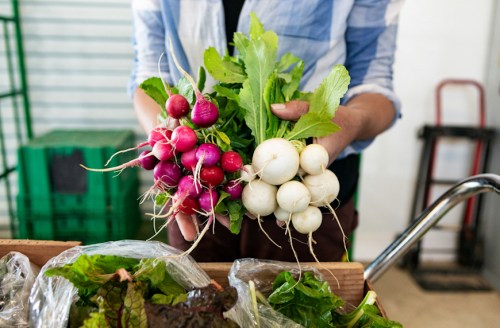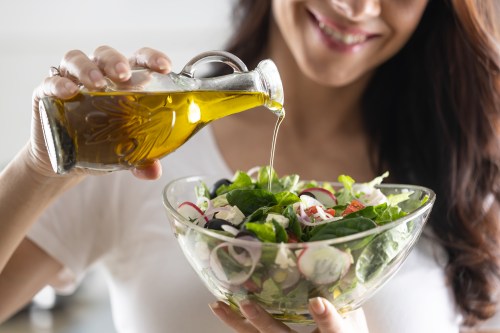Have you met anyone who claims their favorite food—or vegetable, for that matter—is a turnip? Chances aren’t great. After all, its historic backstory is that it was once a “get off the stage” tomato equivalent of Roman times, and Michelle Obama’s iconic Vine asking people to “turnip for what?” can only do so much image rehab. But it’s time for the humble turnip to earn its bragging rights—and place on our tables.
The hearty, winter veg has two parts: the white and purple bulb, and the green leaves. It’s actually a cruciferous vegetable, in the same vein of green leafy staples like kale, Brussels sprouts, and cauliflower—making it one of the healthiest foods you could eat, if only you gave it a chance.
Yes, eating turnips may seem like the vegetable equivalent of joining the Mathletes, but rest assured: the limits do not exist when it comes to turnip’s health benefits. We asked a few experts for the specifics.
What are turnip health benefits, anyways?
1. It is high in inflammation-fighting compounds
“Cruciferous vegetables are some of the healthiest foods, since they contain many antioxidants, as well as compounds known as glucosinolates,” says registered dietitian Whitney English, RDN. Antioxidants, of course, combat inflammation and other damage caused by free radicals in the body. As for glucosinolates, they have been linked to a lower risk of cancer, and support healthy cell production.
2. It’s good for your gut
One cup of cubed raw turnips packs around two grams of fiber, which is more than just a drop in your daily suggested intake. The fiber in turnips help fight bloating, gas, and constipation, while also lowering cholesterol and the risk of chronic illnesses like diabetes, says Brigitte Zeitlin, RD. Since fiber moves slower through your gastrointestinal tract, it helps to stabilize blood sugar levels and satiety.
3. It’s a natural source of folate
Most notably, folate is “an essential nutrient for pregnant women and women thinking of preconception health,” Zeitlin says. Even if you’re not pregnant right now, getting your folate can help support cardiovascular health and increase energy levels, which is why women over 18 should be getting around 400 micrograms per day. You’ll get 20 micrograms of folate in one cup of chopped turnips (five percent of your daily value), and a whopping 107 micrograms (or 27 percent of your daily value) in one cup of chopped turnip greens.
4. It supports Bone health
Just one cup of turnip greens contains 138 micrograms of vitamin K—that’s 153 percent of what you should be getting every day—which aids in bone health and is an important blood clotting agent. Consider this yet more proof that we should all be eating more root vegetable greens and not just throwing them out.
5. Turnips—and their greens—are brain food
“Turnip greens are actually more concentrated with micronutrients like carotenoids such as beta-carotene and lutein,” English says when comparing the root with the greens. In fact, these leafy greens have been shown to aid healthy brain function. The anti-inflammatory properties of lutein also contribute to eye health.
Speaking of healthy foods that experts love, here’s the low-down on avocados:
What’s better for me: turnip greens or the roots themselves?
In case you couldn’t tell from the above, both turnips and their greens are…pretty darn healthy, so you should consider eating both on the reg. Think about the “eat the rainbow” mantra: The turnip is essentially two different colors between the greens and the root. “They both serve up some serious health benefits, but their differing colors offer a different vitamin and nutrient panel from one another,” Zeitlin says.
If you want to get technical, turnip greens can take the trophy—even though you shouldn’t rule either out of your diet. “Eat them both!” says Sharon Palmer, RDN. “Green leafy vegetables are always a super food of the veggie kingdom.” Turnip greens offer the majority of the plant’s vitamin K, vitamin A, vitamin C, folate, manganese, and calcium.
That’s settled. Now, how do I eat—and enjoy—more turnips?
The only downside about turnips is that they’re not exactly user-friendly. They’re not as ubiquitous a staple in people’s diets compared to other root vegetables like carrots and sweet potatoes. But if you take a little bit of time to learn how to use them, you’ll find that they can be a healthy and delicious addition to your winter meals.
When shopping for turnips, look for a plant that has a tennis ball-sized root with a bright purple end. If you default to the biggest veg you can find, you’ll end up with a woody and bitter turnip.
When cooking, keep in mind that turnips tend to taste a bit bitter. To avoid an overpowering flavor, blanch the greens (meaning you boil them for about a minute, then immediately transfer them to ice water to stop the cooking process) and roast the roots to cut down on the sharpness.
As for more specific ideas on how to cook turnips, here are some suggestions:
- Slice the root, season with oil and spices, then throw the pieces on the grill.
- Upgrade your usual roasting technique by slathering turnips in a miso glaze for an extra boost of flavor.
- Add diced roots and stems into soups and stews to up the fiber and phytonutrient composition of any dish.
- English recommends mashing turnips as a potato substitute. “If the turnip taste is too strong, you can also just add them to your mashed potatoes for some extra flavor,” she suggests. This turnip and kale gratin from bon appetit also serves an opportunity to swap potatoes for turnips, and kale for turnip greens. Go all in!
- Use the greens and the roots to make a seasonal salad bowl. Combine with your grain of choice and other vegetables on-hand, top with a dressing, and you’ve got lunch.
Looking for other seasonal vegetables? Here’s the lowdown on cauliflower and its many benefits. And we asked a dietitian to explain just why every health expert loves olive oil.
Sign Up for Our Daily Newsletter
Get all the latest in wellness, trends, food, fitness, beauty, and more delivered right to your inbox.
Got it, you've been added to our email list.










